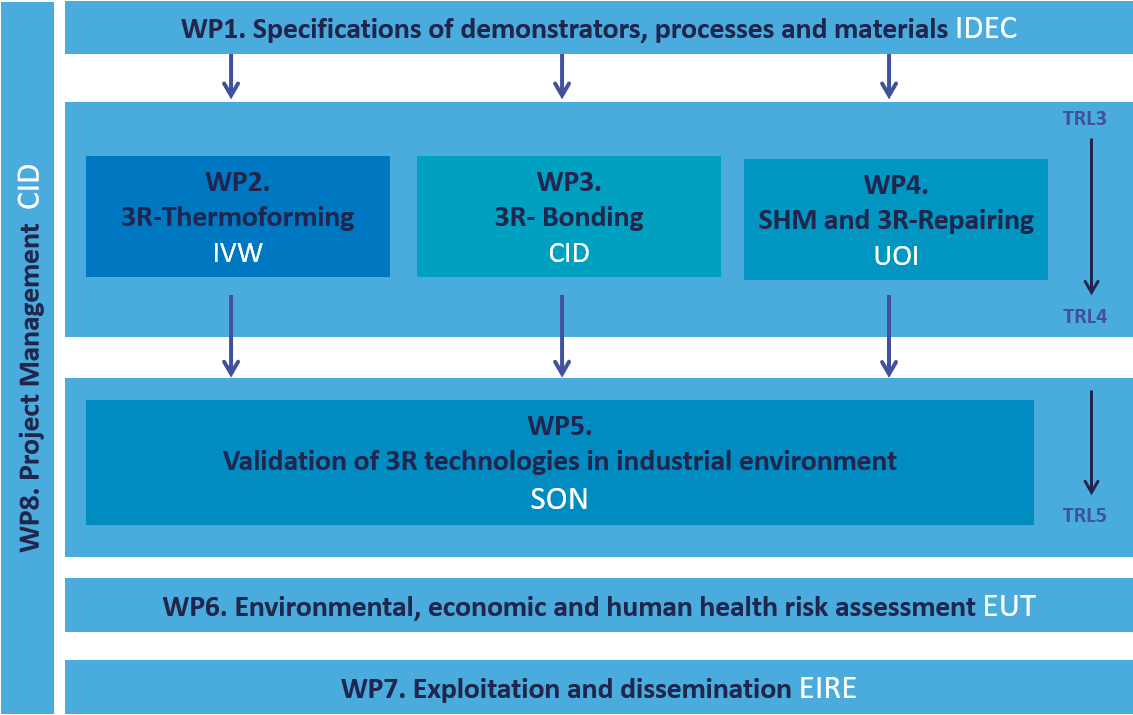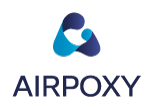Work Plan Structure
To facilitate the work in AIRPOXY, the project contains 8 work packages (WPs). The work packages are subdivided in tasks.
The figure below shows the structure of the project and the interdependencies of the WPs as well as the partners responsible for them.
By clicking on the different WPs you can find out more about the respective tasks and objectives.

Work package 1: Specifications of demonstrators, processes and materials
Lead: IDEC
Objectives:
- To define the demonstrators taking into account the needs to demonstrate thermoforming, bonding and repair technologies.
- To define the requirements (properties) for each demonstrator.
- Coupon level
- Sub component level
- To define raw materials to be used (resin, fibers, protections) and their properties.
- To define testing methods to evaluate the performance and functionalities of demonstrators in order to define the standardisation needs and assessment procedure:
- Coupon level
- Sub component level
Work package 2 – Thermoforming
Lead: IVW
Objectives:
Study of 3R laminate manufacturing and development of a thermoforming process for vitrimer based composite materials.

Objectives:
Study of 3R laminate manufacturing and development of a thermoforming process for vitrimer based composite materials.
- Resin modification to meet process requirements
- Investigation of 2 processing strategies for flat laminate production:
- RTM: infusing reinforcement textiles with 3R resin
- Stacking 3R prepregs with reinforcement textiles, then pressing the stack to laminates
- Thermoforming of 3R laminates
- Discontinuous compression molding (DCM) for webs.
- Continuous compression molding (CCM) for longitudinal stiffeners.
Work Package 3 - Development of 3R-Bonding technologies
Lead: CIDETEC
Objectives:
Objectives:
- Overall objective: to develop two different bonding processes for 3R composite laminates (adhesive bonding and welding)
- Technical objectives:
- To develop a 3R adhesive
- To develop the skin and transverse elements of the Fan-cowl based on 3R resin by RTM
- To develop the nose element of the leading-edge by
- To adapt SQRTM process to produce laminates with 3R surface
- Required tool development for each of both bonding processes
Work Package 4 - SHM and development of 3R – Repair technologies
Lead: UOI
Objectives:
- Main objective: Method development for the repairing of delaminations and debondings in 3R composites
- Assessment of the knock down effect at several levels
Direct mechanical Evaluation
- Application of SHM in relation to production processes & chemical bonding techniques
Indirect Evaluation
- Development and optimization of the repair conditions for each type of generated damages.
- SHM application to determine best repair conditions.
- Predict with the simulation tools such structures damages and mechanical properties.
Work Package 5 – Validation in industrial environment
Lead: SONACA
Objectives:

Objectives:
- Processes to manufacture the elements:
- SQRTM (nose)
- RTM (skin and transverse stiffener)
- Thermoforming (webs and longitudinal stiffener)
Validation: NDT & dimensional control
- Bonding processes to assemble the sub-elements:
- Adhesive bonding (fan-cowl)
- Welding (leading-edge)
Validation: NDT & dimensional control, ILSS, Impacts, Pull-out
- Offline damage assessment
- Online damage assessment
- Repair
Validation: Damage assessment
Work Package 6 - Environmental, economic and human health risk assessment
Lead: EURECAT
Objectives:
To assess the non-technological benefits of the developed solutions:
- To determine the environmental profile of AIRPOXY solutions by a Life Cycle Assessment (LCA) addressing eco-design criteria and end-of-life aspects in order to demonstrate:
- Reductions related with the fuel consumption and CO2emissions
- Reduction of the quantity of landfilled waste
- The quality of material obtained and the environmental implications associated
- Recyclability and reuse enhanced properties of AIRPOXY products
- To evaluate the Life Cycle Cost (LCC) of AIRPOXY solutions and help in selecting the most suitable option managing simultaneously environmental and economic impacts:
- Reduction of manufacturing costs of composite parts in 37% compared with autoclave processes
- Reduction of assembly costs of composite parts in 53% compared with adhesive bonding
- Reduction of repair costs of composite parts in 50% compared with patching process
- Significant reduction process cost (to be estimated)
- Reduction in 90% the labour costs
- Assessment of the human health risk of the new processing technologies and the new resins
.
Work Package 7 - Exploitation and Dissemination
Lead: EIRE
Objectives:
- Coordination of communication and dissemination of project outputs, approaches and results to target groups, users and communities;
- Development of training programs for new employees who will operate on new materials and machinery;
- Management of exploitation of project results and guarantee sustainability, including next steps for the development, industrialisation and certification roadmap;
- Generation of business model canvas to identify new supply chain and business models;
- Generation of commercialisation roadmap and business plan for selected business cases.
- Standardisation and certification activities to facilitate acceptance and utilisation of AIRPOXY solutions in the aeronautic sector
Work Package 8 - Project Management
Lead: CIDETEC![]()
Objectives:
- Ensure the high quality of work performed in the project
- Monitor contractual commitments
- Ensure a good coordination between partners
- Manage project risks

